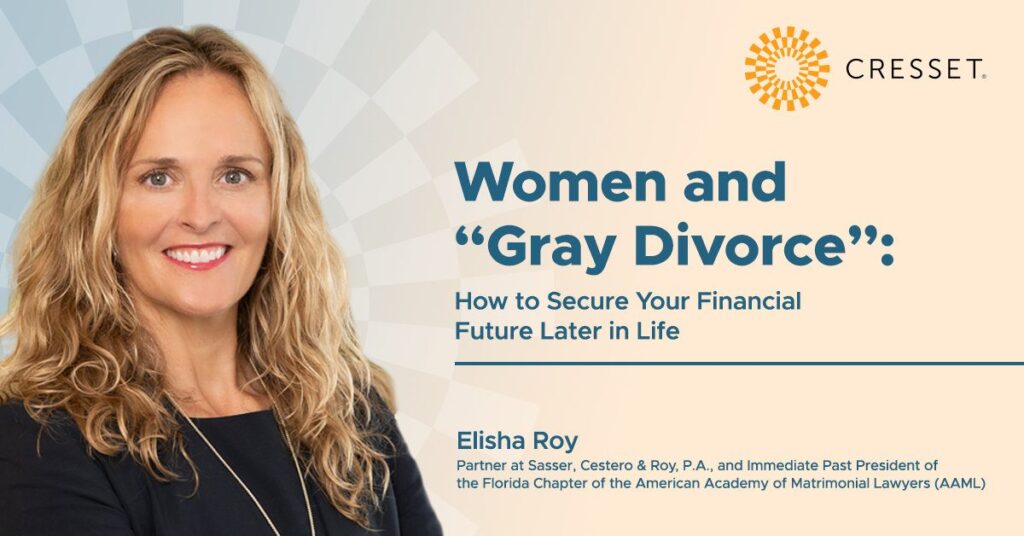
“Gray divorce” refers to an interesting phenomenon that has taken hold in recent years. What is gray divorce? Simply put, more people are getting divorced later in life. What’s not so simple is the potential impact on the finances of those suddenly finding themselves single after many years, particularly women.
According to the U.S. Census Department, nearly 35 percent of Americans who recently got divorced are age 55 or older, more than twice the rate of any other age group surveyed.
To further explore this new reality, and specifically the impact on women, Cresset connected with Elisha Roy, Partner at Sasser, Cestero & Roy, P.A., and Immediate Past President of the Florida Chapter of the American Academy of Matrimonial Lawyers (AAML). Below we discuss what women considering a divorce in the second half of life need to know to secure the best possible outcome and long-term financial security.
Elisha, let’s dive into this trend of divorce later in life, particularly what it means for women. What unique circumstances do they face in your experience?
This is an interesting issue, and it obviously depends on the woman. I’ll address this from the standpoint of a woman who is not the breadwinner and may not be aware of the details of the family’s financial strategy. When I see these later-in-life divorces, it is often because of disagreements in how to handle family wealth and estate planning or succession planning in that regard. As an example, the parties may not agree on what to leave to children versus charitable organizations. Often, when one spouse has been less involved in the finances during the marriage and is seeking to intervene later in life, the opinions can be discounted by the breadwinning spouse. A divorce can give the wife control over her distributed assets (in broad strokes one half of the marital estate), so she can independently make those decisions.
Numerous issues can come up in these divorces. For example, sometimes irrevocable trusts are suggested as an estate planning method. However, transferring assets into an irrevocable trust removes those assets from the marital estate for division. If an irrevocable trust has already been established, it is important to know this before filing for divorce or deciding to take that path, as knowing what is in the marital estate for division is important to ensure financial security.
Alimony or spousal support is also a consideration. Often, depending on the size of the estate, no alimony is awarded if the assets distributed would generate enough interest income to support that spouse’s needs. It is important the spouse who has not worked understands what this means and the interplay between equitable distribution and alimony. It is important to work with a team of advisors to understand what the needs of the spouse are and how much of those needs can be met with the financial resources distributed.
As you say, for some of these women, their spouses took the lead in managing the family’s finances/investments over the course of their marriage. What are the first steps in “taking ownership” of their financial situation going forward? How important is that to avoid gray divorce regrets?
This is very important and one of my favorite parts of what I do. I love seeing a woman who comes to me with virtually no understanding of finances or what life will look like after divorce and assisting her with that new reality. Usually, that starts with a forensic accountant who can help determine lifestyle/need, and then the best- and worst-case scenarios of alimony and income from assets distributed. That provides a basic idea of the dollars available on an annual basis, which allows us to discuss how to best use those dollars. Thereafter, it is important to involve a financial planner or full-service wealth management firm to invest those assets, help create a budget, assist in the paying of bills, etc. That is one of the most critical parts of the process, as a woman can sometimes be nervous about life after gray divorce and her ability to meet her lifestyle needs and continue activities, etc. Demonstrating how the money can work for them and what they can afford is very reassuring. It can be hard to part with a home and cherished assets, but as women going through divorce start to own their own financial futures, the empowerment is amazing.
There is a saying that “equal is not the same as fair” when it comes to distribution of assets in a divorce. Can you elaborate on that and why it is so important for those going through a divorce to carefully weigh the division of assets?
I could write an essay on this one! Equitable distribution definitely does not mean fair. More importantly, equitable distribution and alimony are two different things, which can also be confusing. Perhaps a couple has four properties, so one might think that each spouse should get two in the divorce. But can you afford those homes based on what your alimony and income will be? That can require a different way of thinking about the division of assets. Clearly, this can get rather complex.
In the simplest of terms, it is important that we first know what is being divided. As an example, if the husband is the beneficiary of a trust or a non-marital asset that has contributed to the couple’s lifestyle, or there is a prenuptial agreement, what will be distributed may be less than what the couple enjoyed during their marriage. Also, many estate planning vehicles used by high-net-worth couples, irrevocable trusts as an example, prevent those assets from being distributed, which means there may be much less to divide than expected. In that case, grey divorce alimony becomes even more of a factor.
It is also important to know that you can actually afford the assets that are being distributed (maintenance, taxes, etc.) That is why a team approach is important. A financial expert can help advise about how much money a divorcee will have on a monthly basis and how best to use it, with the goal of ensuring that money lasts.
What do women potentially “leave on the table” if they don’t bring together their divorce attorney, financial planner, and other advisors during the divorce process?
Many people have the misunderstanding that lawyers make the divorce process harder or worse. I disagree … assuming you have the right lawyer! If you hire a creative, smart, problem-solving lawyer, that can be one of the most important things you do in high-net-worth divorce situations. You must know what you have, what your rights are, and how those interplay to be able to make an educated decision on settlement. I believe the common misunderstanding is that if you hire lawyers you have to expect to “fight.” Lawyers are like the teachers; you need them to help you make the best decisions, and if that result cannot occur because the other side is unreasonable, you are prepared if necessary to fight. However, you don’t always have to battle, and most cases do not end up that way.
A financial planner/advisor helps the client know the good, bad, and ugly of their financial situation. Whereas the lawyer can lay out the best- and worst-case scenarios of the possible resolution of the case, the financial advisor can advise about what those best- and worst-case scenarios look like from an income and asset perspective. That way, a woman going through divorce knows what she can and cannot afford and what does or does not make sense from a financial perspective going forward.
At what point should a woman bring that team of advisors together? Do many women wait too long in the divorce proceedings?
I find many women never get the team together. They want to continue to rely on the advisor that worked for the husband or the family. I do not recommend that except for very rare circumstances. A woman needs someone looking out for her and her best interests, such as how to invest with the appropriate level of risk, given her wants/needs and age. I generally have a forensic accountant do this at the beginning of the process and then have them consult with an advisor, but I can certainly see the benefit of having the full team together as soon as possible.
Divorce is obviously a hugely emotional, and sometimes traumatic, experience. From your experience, how are women who’ve gone through it able to emerge both confident and optimistic about the future?
A good lawyer and team of advisors certainly helps. Surround yourself with people who share the goal of seeing you emerge better at the “end of the tunnel.” Professionals who will explain the whole process and provide realistic outcomes. And if there are children involved, who is looking to preserve their wellbeing? That may mean finding a qualified therapist who can assist with ongoing coping skills.
I find many women in long-term relationships continue to deal with the former spouse the same way they dealt with them while married; it didn’t work then, it likely won’t work after the fact. So, learning to be stronger, to stand up for themselves, and what to react to and not react to is essential. I really enjoy watching women emerge stronger on the other side. That is incredibly gratifying for everyone involved.
If you would like to discuss your family wealth planning needs, please reach out and we would be happy to schedule a call.
The information above is not intended to provide specific legal advice. It is recommended that anyone with questions on this topic contact a qualified family law attorney.
About Cresset
Cresset is an independent, award-winning multi-family office and private investment firm with more than $65 billion in assets under management (as of 4/1/25). Cresset serves the unique needs of entrepreneurs, CEO founders, wealth creators, executives, and partners, as well as high-net-worth and multi-generational families. Our goal is to deliver a new paradigm for wealth management, giving you time to pursue what matters to you most.
https://cressetcapital.com/disclosures/
